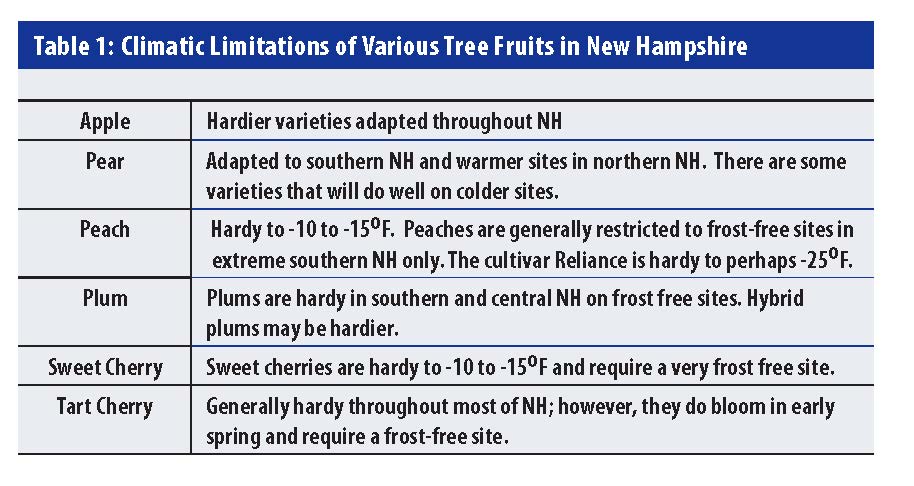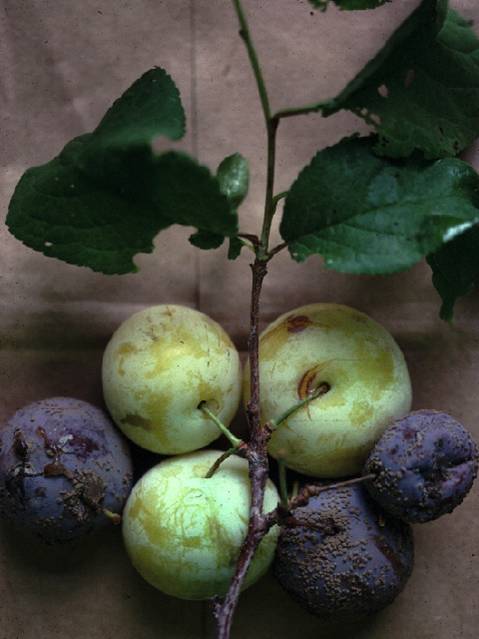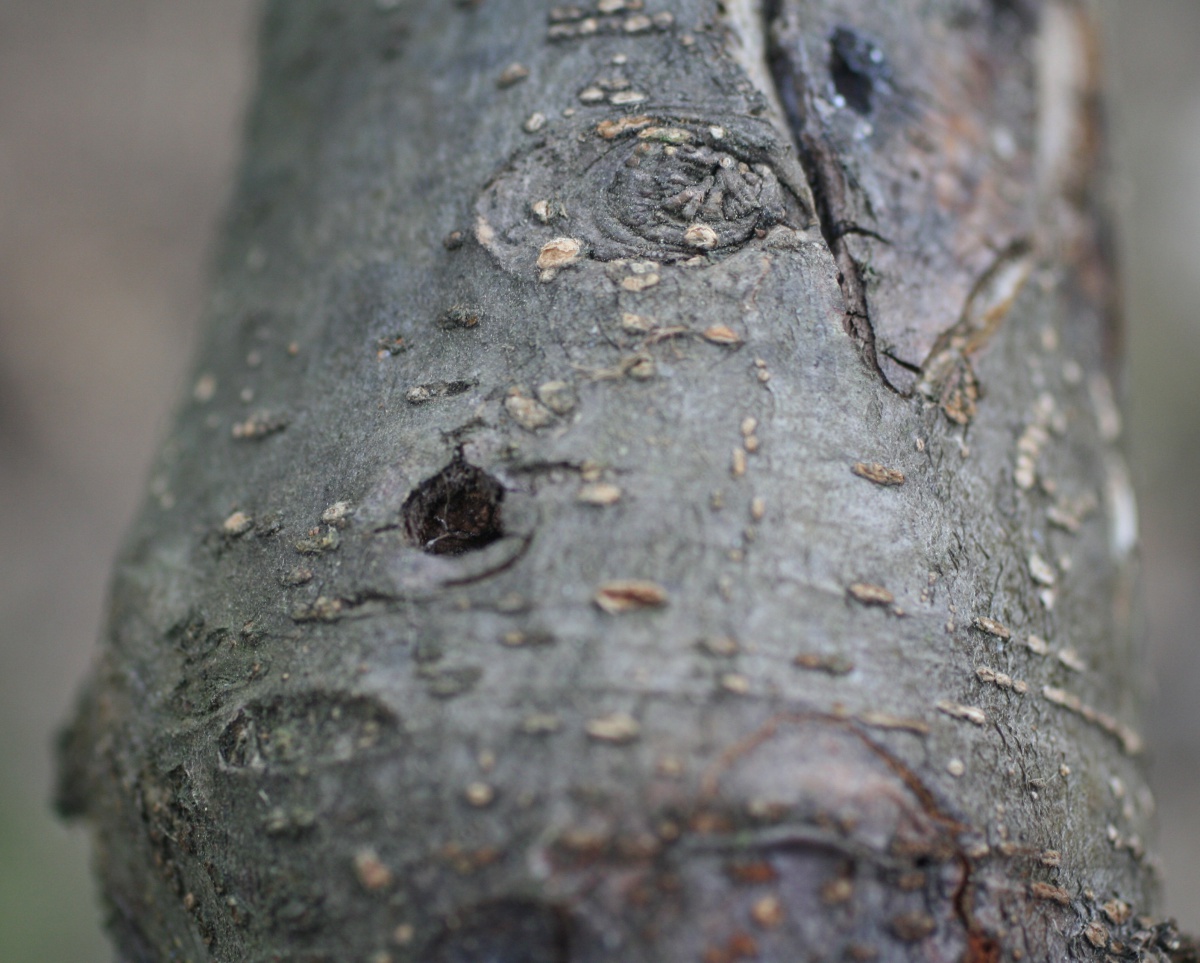Pruning and pest management – these two chores can be discouraging tasks for many home tree fruit growers. Is it possible to grow tree fruits with limited inputs? With proper tree selection and site preparation, the answer can be yes.
Site Selection
The first and perhaps most important issue is site selection. Fruit trees will grow and produce best if planted on deep, well-drained sandy loams with good moisture and nutrient-holding capacity. In addition, full sunlight nearly all day long is essential. Trees that do not receive at least 6-8 hours of direct sunlight each day will be “leggy” and will produce few flowers and fruits. In addition, full sunlight promotes quick drying after rain events, reducing the risk of disease pressure.
Plant fruit trees on a slope that allows cold air to drain to lower levels. Plantings nearer the top of a slope will usually suffer less spring frost injury than those at the bottom.
Soil Preparation
Perennial weed pressure can greatly impact young fruit trees. These weeds will reduce young tree growth and if allowed to grow up around tree trunks, they increase the risk of trunk borer and vole damage.
Prepare soil thoroughly by plowing, tilling or spading before planting. Have soil tested and amend the soil before planting based on soil test recommendations.
Be realistic in your expectations. Some parts of New Hampshire are just too cold for tender tree fruits such as peach (Table 1).

What Should I Buy?
First, it is important to note that all fruit trees are grafted. Some fruit varieties are grafted onto seedlings and generally produce large trees. Others are grafted onto dwarfing rootstocks producing trees that are smaller.
Dwarf and semi-dwarf trees generally make more sense for home gardeners than seedling (standard or full-sized) trees. Dwarf trees take up less space, bear fruit at an earlier age, and are easier to spray and prune.
While dwarf apple trees are easy to find in the nursery trade, and dwarf pears are becoming more available, dwarf peaches, nectarines, plums, cherries, and apricots are not.
Start with a reputable mail order fruit tree nursery or local garden center. For apple, the dwarfing rootstocks M.26 and Bud 9 work well in New Hampshire, producing trees that generally mature at 10 feet or less. Order both the variety and rootstock you want; for example, specify a variety like Honeycrisp on M.26 when ordering.
For dwarf pear trees, you will need to order your varieties on a dwarfing rootstock such as OHxF 333, 40, 513, or 87 rootstocks. Standard or fullsized pear trees are suitable except where space is limited.
Varieties
There are hundreds of tree fruit varieties that will grow well in New Hampshire. Table 2 lists those that will require the least amount of pest control. Varieties in Table 2 are listed in the approximate order of their ripening.

Cross-pollination
Apples, pears, plums, apricots and sweet cherries all either require cross-pollination to set fruit or will set much better crops when cross pollination occurs (self-fruitful varieties are noted in Table 2).
For cross-pollination to occur, two different varieties of the same fruit must be grown (i.e. CrimsonCrisp and Liberty apples). Sour cherries will not cross-pollinate sweet cherries and European plums will not cross-pollinate Japanese plums. Not all combinations of varieties are compatible. These limitations are generally noted in catalog descriptions of the individual varieties. Native bees or honey bees are required to effect cross-pollination.
Planting
Fruit trees should be planted in early spring. Dig a hole large enough to accommodate the entire root system. Set dwarf trees so that the graft union between the variety and rootstock is 2 to 3 inches above ground. For standard or full-sized trees, set trees 2 to 3 inches deeper than they were set in the nursery.
When planting, fill the hole half-way with soil. Add enough water to thoroughly soak the root zone. Finish backfilling the planting hole, firming the soil. Fill to ground level to prevent winter ice damage.

Winter Sun Protection
Injury to the south and west side of trunks of young fruit trees (Southwest Injury) can occur on cold, clear winter days. The dark bark traps the sun’s heat, and freeze-thaw cycles cause the bark to crack. To prevent Southwest Injury, apply a very light coat of a mixture of equal amounts of water and white interior latex paint to the south and west sides of the trunk from the ground up to the first branch. Apply this paint/water mixture in late autumn.
Pest Management in the Home Orchard
Planting apple scab resistant apple varieties, pears that are resistant to fire blight, and other tree fruit varieties adapted to NH growing conditions will reduce the need for spraying significantly. However, there may still be the need for some pest control intervention in some years.
Plum curculio is one insect pest that will attack all these fruits. It is active during the first 2-3 weeks immediately after bloom. So far, pesticide-free control of this pest has been elusive. One option home growers can consider is the use of Surround® (a kaolin clay product). This material coats the fruits, deterring the adults from laying eggs in the developing fruit.


Brown rot affects fruits of peach, nectarine, plum, cherry and apricot, and may be a problem in some years. Sanitation – removal of any shriveled, dried fruits that remain on the tree – is one key to management of this disease with limited pesticide intervention. Many of the plum varieties listed above have some resistance to this disease as well as the devastating disease, Black Knot.


Keeping weed and grass pressure low around tree trunks may reduce trunk borer infestation. Painting trunks with white, interior latex paint may also help with borer control.
Voles
Voles are another common pest in home orchards. Melting snows in late winter often reveal their winter feeding damage to young fruit trees. Partial or complete girdling of trees by voles usually results in loss of the tree.

Wrap-around plastic guards are not recommended. These offer borers protection from predatory birds and the like. In addition, they often fail during the winter, exposing part of the trunk to girdling.

Wire vole guards (made from 1/4 inch mesh galvanized hardware cloth) offer superior protection and often last for the life of the tree. Guards should be 18 inches tall with one inch buried in the ground. They should be 6 inches in diameter.

Deer
Often the biggest challenge a home fruit tree grower faces is feeding by deer. Deer are particularly partial to apple and sweet cherry shoot tips and fruiting spurs, but will attack all tree fruits. Feeding usually occurs throughout the year, but is heaviest when new, succulent growth is present and in winter when food is in short supply.
Controlling deer damage is essential. There are several taste and odor repellents available. Most use putrefied eggs or capsaicin (the chemical that confers “heat” in hot peppers) as the repelling agent. These and bars of soap may help in low pressure situations; however, the only completely effective measure for preventing deer damage is fencing.
A secure, 6-8 foot high fence around the home orchard is recommended. If just a few trees are planted, individual wire cages, 6 feet high, around each tree is an alternative solution.

Birds
Cherries are especially attractive to birds. It is not uncommon for the entire cherry crop to be destroyed by birds, especially if Cedar Waxwings are present. Netting offers the best protection but application and removal is difficult at best as trees grow. Flash tape, scare eye balloons and other visual deterrents offer limited control. for more information, see the publication Bird Damage Prevention for Northern New England Fruit Growers.
Download the Resource for the complete fact sheet.
